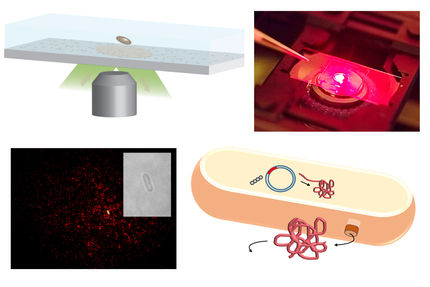Portable High-Resolution NMR Sensor Unveiled at Berkeley
A portable device makes it possible for the first time ever to take high-resolution NMR spectroscopy out of the laboratory and into the field for use on samples of any size. This portable NMR sensor was developed by a collaboration of researchers with the U.S. Department of Energy's Lawrence Berkeley National Laboratory (Berkeley Lab), the University of California at Berkeley and the Institute for technical chemistry and Macromolecular Chemistry in Aachen, Germany.
"Our device does not compete with the superconducting magnets that are used to study proteins, but there are many applications, besides homeland security, where you can't bring samples from the field to the laboratory, including medical diagnosis, archaeological analysis, or the exploration of objects in space, like planets or moons," said Vasiliki Demas. Demas is a member of the research groups of Jeffrey Reimer, who holds joint appointments with Berkeley Lab's Energy and Environmental Technologies Division and UC Berkeley's Chemical Engineering Department, and Alexander Pines, a chemist with joint appointments at Berkeley Lab's Materials Sciences Division and UC Berkeley's Chemistry Department.
Until recently, high resolution NMR spectroscopy could only be done by placing a sample inside the bore of a very large stationary magnet that produces a strong, uniform magnetic field. Portable NMR systems with open, single-sided probes, have been built, but the lack of uniformity in their magnetic fields limit them to low resolution.
"The variations within the magnetic fields of previous portable NMR devices are usually orders of magnitude too large to detect chemical shifts," said Demas. "These devices mainly yield relaxation times as a crude estimate of a sample's composition."
In 2001, an effort led by Pines, Meriles, and Dimitris Sakellariou, formerly with the UC Berkeley chemistry department, demonstrated a technique for obtaining high-resolution NMR spectroscopy data from samples in a grossly nonuniform magnetic field. In this "ex situ" method, the lack of uniformity in the magnetic field is compensated for by zapping a sample with a series of rf pulses that are precisely varied in energy, duration and timing. In this configuration for ex-situ high-resolution NMR spectroscopy, an inner magnet opposes the field created by the outer magnet to induce a sweet spot 7 millimeters above the magnet surface where a sample can be placed for analysis. An rf coil is positioned to optimize its interaction with the static magnetic field.
The authors of a Science paper applied the ex-situ technique in a portable single-sided sensor device, which, for these experiments, was configured for high resolution NMR spectroscopy. Two concentric U-shaped permanent rare earth magnets (Neodymium-Iron-Boron) were arranged to create a magnetic "sweet spot" about seven millimeters above the active magnet surface. In this sweet spot, the static magnetic field is parallel to the plane and reaches a field strength of 0.2 Tesla. The rf pulses were generated through a rectangular rf coil that is shaped and positioned with the inner of the rare earth magnets to optimize the interaction between the static magnetic field and the magnetic fields generated by the rf pulses. When a sample is placed in the sweet spot and hit with a carefully orchestrated series of rf pulses the result is an NMR spectrum with a sharp enough resolution to reveal chemical shifts of eight parts per million within three minutes after sample testing begins.
This research was funded the U.S. Department of Energy's Office of Science and by the Deutsche Forschungsgemeinschaft.
Most read news
Topics
Organizations
Other news from the department science

Get the analytics and lab tech industry in your inbox
By submitting this form you agree that LUMITOS AG will send you the newsletter(s) selected above by email. Your data will not be passed on to third parties. Your data will be stored and processed in accordance with our data protection regulations. LUMITOS may contact you by email for the purpose of advertising or market and opinion surveys. You can revoke your consent at any time without giving reasons to LUMITOS AG, Ernst-Augustin-Str. 2, 12489 Berlin, Germany or by e-mail at revoke@lumitos.com with effect for the future. In addition, each email contains a link to unsubscribe from the corresponding newsletter.
Most read news
More news from our other portals
Last viewed contents
CyBio and Macherey-Nagel collaborate to develop applications for automated DNA/RNA preparation





















































